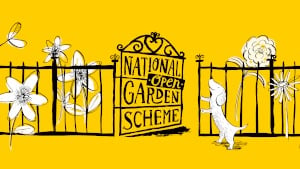About 1 Scotsmansfield
‘Scotsmansfield’ (listed Grade II, not open), was built on the lower slopes of the Long Mynd in 1908, by leading Arts & Crafts architect & founding member of the Art Workers’ Guild, Sir Ernest Newton. The location of a ‘small country house’ of this period was dependent on its ‘prospect & aspect’. Accordingly, Scotsmansfield is distinguished by its long, south-facing aspect, commanding views over the gardens, towards the market town of Church Stretton and surrounding Shropshire Hills – all now in a designated ‘National Landscape’.
The house lost many of its acres (which once included Rectory Wood) in the 1950s & house & gardens were divided into three in the 1960s. Parts of the garden of No.1 were neglected for many years; by 2014 (when current owners arrived), extensive brambles & scrub had been cleared, revealing terraces & lawns, walls, yew hedges & a group of mature North American conifers, legacies of original layout. A lily pond, constructed in the late 1920s, was also uncovered, having been buried beneath collapsed walls and vegetation.
Today, this garden extends to ¾ acre. It has several distinct areas: the oak bank, managed for wild-flowers; shepherd’s hut, enveloped with roses; woodland fernery, with wide collection of Dryopteris & Polystichum, as well as specimen tree ferns & sculptures; a new border, framed by pleached hornbeams – replacing huge conifer, lost to Storm Arwen, November 2021 – featuring irises (mostly gone by midsummer), roses, lavender, lilies & verbena; lily pond surrounded by roses & perennials; mixed borders, generously & intricately planted with trees, shrubs, perennials & single & double roses, some highly fragrant & at their best in mid-summer; formal garden surrounded by yew hedges, with characterful topiary birds & plenty more roses in many hues of white & cream; richly-planted terraced banks; two sheltered terraces, with lavishly planted pots; numerous places to sit, relax & enjoy tea and cake. Designed to complement the house & its setting, the garden is a collection of favourite plants; a celebration of colour, shape, texture, scent, light & shadow & an invitation to many birds, butterflies, moths, dragonflies, bats, bees, newts & frogs. It is intended to offer moments of drama, sometimes verging on chaos, & periods of serenity, with places to sit & contemplate the woodlands & hills. Much of what visitors now see has been developed since early 2015 – & much remains to be done!
.

.jpg)
.jpg)
.jpg)
.jpg)
.jpg)
.jpg)
.jpg)
.jpg)
.jpg)
.jpg)
.jpg)
.jpg)
.jpg)
.jpg)
.jpg)
.jpg)
.jpg)
.jpg)


.jpg)
.jpg)

.jpg)
.jpg)
.jpg)
.jpg)